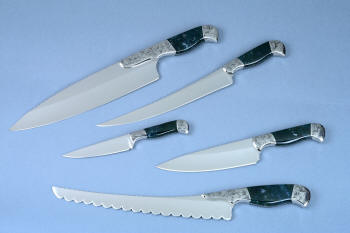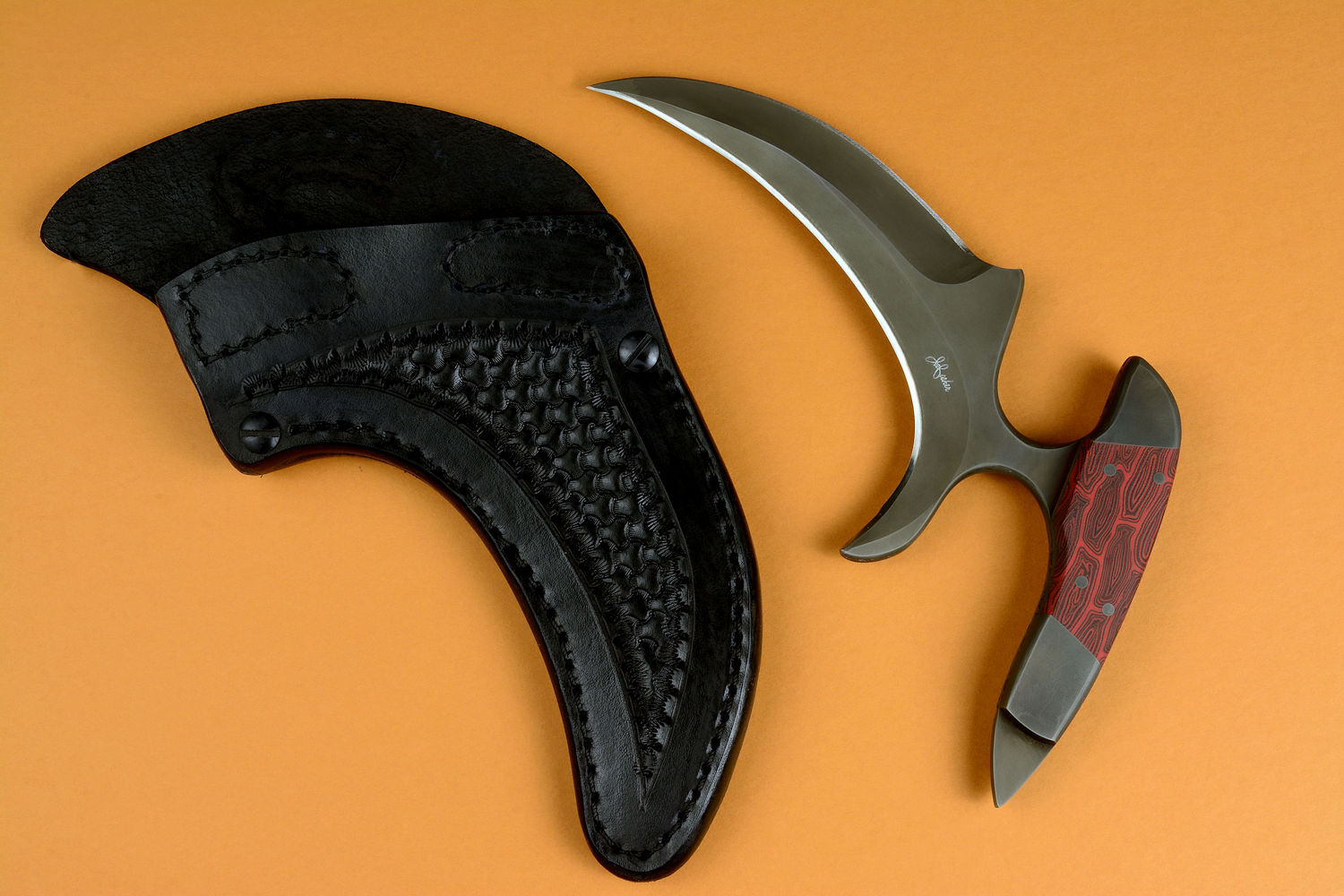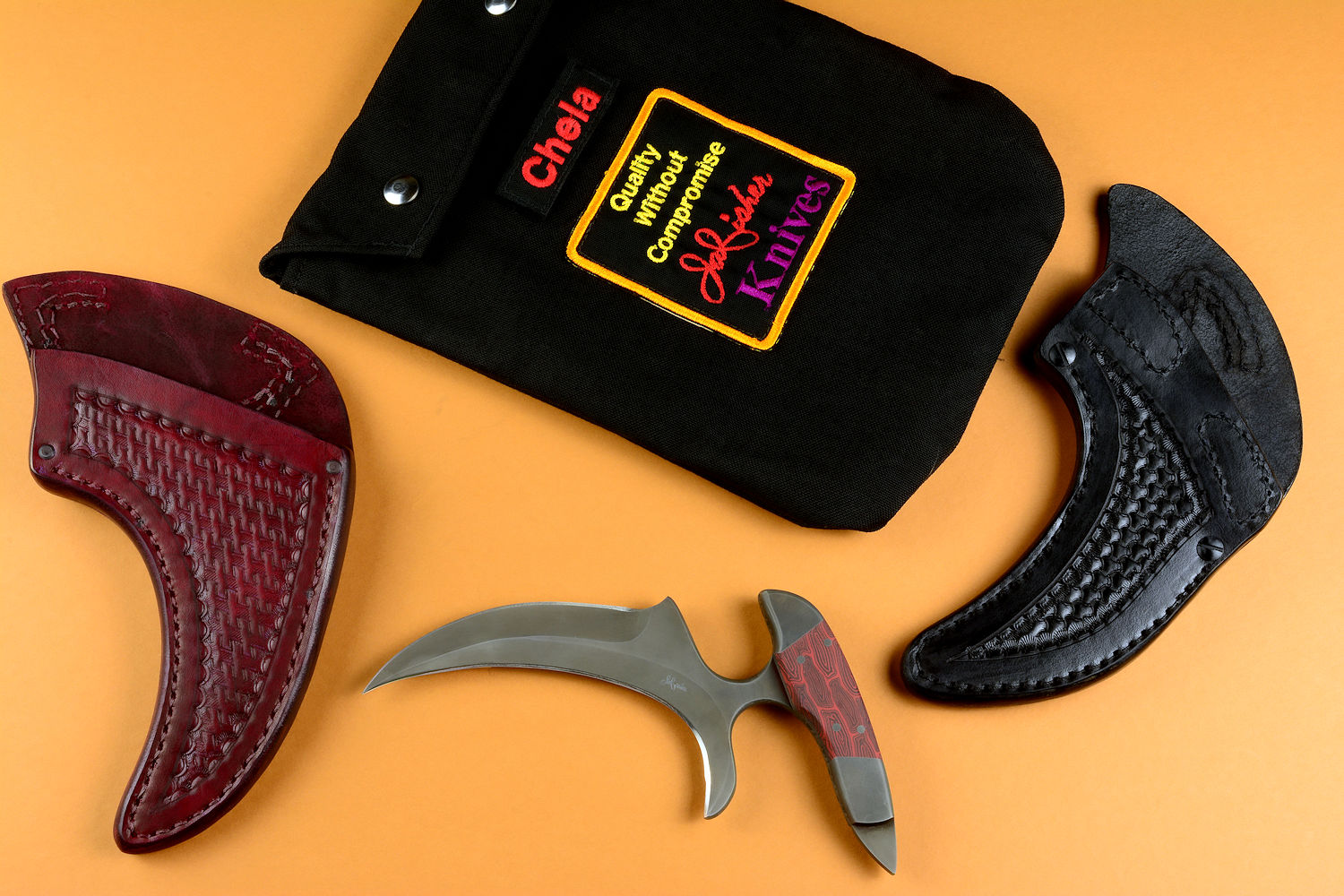"Chela" Karambit Knife
NOTICE!
I've made a new layout for the tactical knife descriptions, seen
on this page. I've separated the
components, briefly describing them in individual boxes. In those boxes
are links to dedicated pages describing everything about the part,
component, or accessory. The pages are substantial, and offer the
history, operation, materials, use, mounting, and care of each
accessory.
"Chela" Tactical, Defense,
Karambit (Shadow Line)
With
Post-Locking Heavy Leather Sheath and Tension Leather Sheath
A truly unique design, combining the sure grip of a push-punch dagger
and a blade of a double-edged karambit, with two distinctive sheaths
Thanks, J. N.!
I have opened the box with the new knives and I am very happy with them! I have taken them with me to show to some other
knife enthusiasts and they have all been really impressed and in awe of these blades.
This is a very unique knife and I particularly like the smooth flowing curves of this blade. It is a bit different than most
Karambit blades because of the push dagger handle and this is what attracted me to this knife. I love having this and showing
it off to friends and family. Once you hold it with the push dagger handle you realize this would be an awesome knife to be
using in tactical situations. The weight, the feel, the perfect grip of the handle make this an unusual and perfect knife to
have. Thank you Jay for this awesome knife.
Thank you for being patient with me. I appreciate your work and even more appreciate your friendship and the communication
-J. N.
Included:
The Knife
- Size: Greatest length overall max: 8.6" (21.8 cm),
Greatest width max at handle: 4.75" (12.1 cm), Blade Length at cutting edge:
5.5" (14 cm), Thickness: 0.264" (6.7 mm)
- Weight: 11.7 oz. (332 grams)
- Blade: 440C High Chromium Martensitic Stainless Tool Steel, Hardened and Tempered, T4 Specialty Cryogenically treated to Rockwell C59, proprietary surface oxide treatment "Ghost Slate."
- Type/Purpose/Origin: In a unique design, the
combination of a double-edged karambit sickle-type blade and a
push-punch dagger handle come together for a serious defensive and
tactical knife, with keen cutting potential and serious presence.
The knife is named "Chela" which is the claw-bone of a crustacean or
arachnid, resembling the shape of the tool. The karambit has its
history in ancient harvesting, and has developed into a common knife
profile and design. This is one of the more aggressive patterns,
with double edges on the blade.
- Blade Steel Alloy: The Chela
blade is a well-proven standard, the hypereutectoid, high alloy martensitic
stainless tool steel, 440C. This is my most
requested steel for a reason. When properly treated, it's a
dependable, reliable workhorse of extremely high corrosion
resistance, good toughness and high wear resistance. The extremely
high chromium of 440C along with the high carbon and moderate
molybdenum results in profuse chromium carbides, increasing
corrosion resistance as well as wear resistance. There is a reason
that 440C is the steel that all other stainless tool steels are
compared to. This steel is suitable for marine saltwater use.
- Heat Treatment: To bring this steel to its
zenith, I used my proprietary T4 deep cryogenic process in heat
treating this blade; it's a highly detailed, extremely sophisticated
process that takes 36 individual steps and takes over a week long.
The result of this is an incredibly wear-resistant blade that has
extremely high carbide development, fine grain, and extremely high
toughness. Asperity is reduced; the microstructure development is
superior to any other typical handmade knife, and far above any
factory or manufactured knife. This is, simply put, 440C martensitic
stainless steel at its very finest advanced condition. The result is a
very tough, hard,
wear-resistant stainless steel. This is a testament to my
determination to make the very best knives, steels, treatments
and kits in the modern world. I know of no one else who has
advanced the treatment to this level; it's unheard of in the
metals and knifemaking field. This is, simply
put, 440C at its very finest advanced condition.
More about the heat treating designation.
- Blade Design and Geometry: The first striking
thing about this blade is that it's double edged. The exterior
convex edge has an abrupt hollow grind that I accomplished with a 3"
diameter wheel, a very difficult grind to do well. This leaves
plenty of thickness in the central spine to support the aggressive,
slender tip, and gives good mass to the blade overall, stiffening
the cross-section of the blade. The concave grind is a taper grind,
smooth and even and sweeping about a radical curve of approximately
150 degrees. Though hard to define, this creates a total edge length
of about 6". Combine this with the convex edge, and this small
blade has over 10" of combined cutting edge! The blade base has very large
quillons to protect the hand from the edges, giving more stiffness
and control with a rounded, contoured surface that is not abrasive
to the hand.
- Blade Finish: The blade is finished in my flat,
dark "Shadow" line of
counterterrorism, rescue, and tactical knife finishes. Answering
the request for completely subdued and non-reflective
surfaces, I developed the Shadow Line with my Ghost
Slate finish. This means darkening in a permanent
fashion the stainless steel of the knife, to color-compliment
the sheaths. Read more about
my Shadow Line and Ghost Slate finish on my
Counterterrorism Knives page
at this bookmark.
- Bolsters: I bolstered the knife in my zero-care
304 austenitic stainless steel standard, for the most reliable,
tough, and durable material. This is the same steel that stainless
and marine-grade fasteners are made of; it's completely care-free.
The bolsters are dovetailed to support the handle material and offer
a thicker grip for the hand. They are attached with multiple
zero-clearance peened pins for permanence.
- Handle: The handle I chose for this knife is
tortoiseshell-pattern black and red G10 fiberglass/epoxy composite.
It's doublet-mounted with black and gray Micarta® phenolic for
contrast along the knife tang. These are very tough materials, and should last indefinitely with little
care. The finish is media-blasted for grip improvement, and the
handle scales are secured with four stainless steel pins. The handle
scales and bolsters are contoured together for comfort and grip
security. The spine of the knife is at full thickness in the handle,
which has been internally milled for weight reduction, and is fully fileworked
with a bold pattern for handmade distinction. The handle has a
"talon," a feature proven to be useful in my other tactical, combat,
and counterterrorism knives, for breaching, glass breaking, and
defense in hammer grip style.
- Balance and Feel: For a knife of this design,
balance is hard to define, but the weight balance is right at the
"bridge" where the fingers are closest in standard grip style. But
what is standard in such an unusual design? With the forefinger at
the convex edge side, the talon on the knife handle is at the butt
of the hand, making for a good hammer-fist grip that is solid and
secure; the thumb lays atop the opposite bolster which offers good
width to apply pressure and stability. This seems logical for a
punching motion. In reverse grip, the thumb lays atop the talon and
the bridge of the handle-to-blade junction is between the long
finger and the ring finger, more central in the hand. In this grip a
sweeping, scooping motion employs the radical inside curve of the
cutting edge. Since there will be many more grip styles in this
unusual blade, the owner will surely have his favorites.
- This is an advanced blade with applications of a
defensive weapon in close quarters combat,
or a tool that could not easily be defeated or guarded against, since
it's basically all edges and an invasive point. It's also great for
harvesting rice and grain, which is the original purpose of the
karambit blade, historically.
Included:
The Sheaths
The Post Lock Leather Sheath
- Weight: 7.0 oz. (198 grams)
- Materials: 9-10 oz. Leather Shoulder, Nylon
high strength thread, stainless steel Chicago screws, stainless
steel dot snaps
- Description: I've created an advanced leather
sheath for this knife, based on client feedback and necessity of
safety and strength for daily carry. My clients may typically wear a leather
sheath for daily carry, so I wanted to create a leather sheath that
was as close to indestructible as leather can be. I started with the
thickness; this is thick shoulder, about 0.2" (5 mm) thick, as heavy as
leather armor, and the heaviest leather straps for rigging, and
twice as thick as the leather on a saddle. I hand-stamped/tooled the
sheath in a tri-weave basketweave design, and dyed it
black. The first thing you'll notice
about the sheath is the front,
covering the knife blade but displaying the handle almost completely.
The high back protects
the wearer from the persuader point. On the sheath front are two "D" shaped tab
stitched points; these are the locations of the two D-shaped
"post"
retention points that engage specific locations on the knife handle.
These posts have stainless steel (corrosion-proof and very strong)
dot snaps that snap to the inside sheath back. When the knife is in
the sheath, these dot snaps are engaged, making two audible and
tactile "snaps" that assure the wearer that the knife is secured.
When snapped, it's impossible for the knife to be removed, to fall,
to vibrate out, or to even be forced from the sheath. This makes
this design a positively-locking leather sheath that can't be forced, even in
the most violent and active situations. When the wearer wants to
remove the knife, he pushes his fingertips into the handle,
unsnapping and folding the front face of the sheath outward,
unsnapping the posts, moving them out of engagement points on the knife handle. Because the front of the
sheath folds, it's made of extra-thick leather and it's reinforced
at that critical point with two 304 stainless steel Chicago screws,
which go completely through the sheath front, welts, and sheath back. This
way, no stress is on the stitching at this point. What about the
stitching? The belt loop I secured with heavy stitching of
nylon, for great strength and durability. The belt loop
will accommodate a 2.5" (6.3 cm) wide belt in a more typical
vertical arrangement. On the welts, back, and front, I
stitched the sheath with double-row stitches, for extreme strength,
stiffening, and durability. The sheath is rounded, contoured,
smoothed, and sealed with lacquer for longevity.
- Casual and PSD wear: Clearly, most of my
tactical and combat gear cannot be mistaken for utility wear. Heavy,
solid kydex sheaths can be bulky and weighty to wear in the casual
sense, nor are they meant to be. The Chela sheath is different.
Because it's hand-tooled leather, more common daily and casual wear
is possible, traditionally on the belt. This makes the knife a good
choice for PSD (Principal Security Detail, or Security Detail) work.
- Simply put: This is the most secure, durable,
and well-constructed leather sheath possible.
The Standard Sheath
- Weight: 7.5 oz. (213 grams)
- Materials: 9-10 oz. Leather Shoulder, Stainless
Steel Fasteners, Nylon Thread
- Description: I wanted to include a more
traditional sheath, with an easier unsheathing ability, so I made
one in heavy leather shoulder, as the above sheath, with a
basketweave tooling pattern. I dyed it in oxblood red to compliment
the G10 handle, and stitched it with heavy nylon thread. Note that
this sheath
is a semi-horizontal sheath, so the knife is held in a somewhat
horizontal position (as much as can be described, since the knife
has such a curved and radically-shaped blade. The triple-row
stitching in the belt loop will accommodate a 1.5" (3.8 cm) wide
belt. This is an unusual sheath, and care must be taken in using it,
since it has NO retention method. If worn with the knife point
facing down, the knife can easily "roll" out of the sheath, but with
the knife point up, the knife has to be "lifted" out of the sheath.
It will make more sense when the owner uses it. This sheath then
allows the fastest unsheathing possible, simply "rolling" the knife
out of the slip.
In any case, I
thought it would be important to have both sheaths for a variety of
wear options for this unusual blade. The sheath is rounded, contoured,
smoothed, and sealed with lacquer for longevity.
- Simply put: This is a horizontal sheath with a
fast, smooth, and easy unsheathing, with a traditional fit and no retention
hassle.
Included:
Storage
- Envelope Bag: 1000 denier Cordura® ballistic
black nylon, waterproof polyurethane coated, inside layered in heavy
polyester felt. Stainless steel dot snaps, embroidered patch, removable
embroidered name patch with hook and loop
I have opened the box with the new knives and I am very happy with them! I have taken them with me to show to some other
knife enthusiasts and they have all been really impressed and in awe of these blades.
This is a very unique knife and I particularly like the smooth flowing curves of this blade. It is a bit different than most
Karambit blades because of the push dagger handle and this is what attracted me to this knife. I love having this and showing
it off to friends and family. Once you hold it with the push dagger handle you realize this would be an awesome knife to be
using in tactical situations. The weight, the feel, the perfect grip of the handle make this an unusual and perfect knife to
have. Thank you Jay for this awesome knife.
Thank you for being patient with me. I appreciate your work and even more appreciate your friendship and the communication
-J. N.


